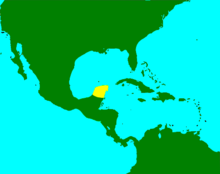Yucatán Peninsula



The Yucatán Peninsula, in Southeastern Mexico, separates the Caribbean Sea from the Gulf of Mexico. The peninsula lies east of the Isthmus of Tehuantepec, a northwestern geographic partition separating the region of Central America from the rest of North America.
The peninsula comprises the Mexican states of Yucatán, Campeche, and Quintana Roo; the northern part of the nation of Belize; and Guatemala's northern department of El Petén. Mexican states situated on the isthmus to the west of the peninsula include Chiapas and Tabasco and is directly within the hurricane belt.
Geology
The peninsula is the surface exposed portion of the larger Yucatan Platform, all of which is composed of carbonate and soluble rocks, being mostly limestone although dolomite and evaporites are also present at various depths. The whole of the Yucatan peninsula is a karst landscape. Sinkholes, locally called cenotes are widespread in the northern lowlands.
According to the Alvarez hypothesis, the Yucatán Peninsula was the site of an ancient asteroid impact which is likely to have caused the mass extinction at the end of the Cretaceous Period. The crater is centered off the north coast of the modern town of Chicxulub (see Chicxulub Crater). The now-famous "Ring of Cenotes" (visible in NASA imagery) outlines one of the shock-waves from this impact event in the rock of ~65 millions years of age, which lies more than 1 km below the modern ground surface, with the rock above the impact strata all being younger in age. The mechanism by which this deeply buried impact crater is reflected by the ring of cenotes at the surface remains to be explained.
Water Resources
The cenotes were (and are) the main water source for many ancient and contemporary Maya people, as there are no rivers and very few lakes on the peninsula.[1]
Vegetation
Short and tall dry tropical jungles are the predominant natural vegetation types of the Yucatan peninsula.
The boundaries between northern Guatemala (El Petén), Mexico (Campeche and Quintana Roo), and western Belize are still occupied by the largest continuous tracts of tropical rainforest in Central America. However, these forests are suffering extensive deforestation.
Etymology
There is a popular myth that the name Yucatán comes from the Yucatec Maya phrase for "listen how they speak," or "I don't understand your words" -- supposedly said by contact period Maya when the first Spanish explorers asked what the area was called. The proper derivation of the word Yucatan is widely debated.
People
The Yucatán Peninsula comprises a significant proportion of the ancient Maya Lowlands (although the Maya culture extended south of the Yucatan peninsula, through present Guatemala and into Honduras and highland Chiapas). There are many Maya archaeological sites throughout the peninsula; some of the better-known are Chichen Itza, Tikal, Tulum and Uxmal. [1], [2] Indigenous Maya and Mestizos of partial Maya descent still make up a sizable portion of the region's population, and Mayan languages are still widely spoken there.
In the late historic and early modern eras, the Yucatan Peninsula was largely a cattle ranching, logging, chicle and henequen production area. Since the 1970s (and the fall of the world henequen and chicle markets due to the advent of synthetic substitutes), the Yucatán Peninsula has reoriented its economy towards tourism, especially in the Mexican state of Quintana Roo. Once a small fishing village, Cancún in the northeast of the peninsula has grown into a thriving city. The Riviera Maya, which stretches along the east coast of the peninsula between Cancún and Tulum, currently has more than 50,000 beds and is visited by many thousands of tourists every year.
Climate
Like much of the Caribbean, the peninsula lies within the Atlantic Hurricane Belt with its almost uniformly flat terrain it is vulnerable to these large storms coming from the east. The 2005 Atlantic Hurricane Season was a particularly bad season for Mexico's tourism industry, with two forceful category 5 storms hitting, Hurricane Emily and Hurricane Wilma. The 2006 Atlantic Hurricane Season was a typical year which left the Yucatán untouched, but in the 2007 Atlantic Hurricane season Yucatan was hit by the Hurricane Dean (also a category 5 storm), nevertheless Dean left little damage on the peninsula despite heavy localized flooding.
Strong storms called nortes can quickly descend on the Yucatán Peninsula any time of year. Although these storms pummel the area with heavy rains and high winds, they tend to be short-lived, clearing after about an hour. The average percentage of days with rain per month ranges from a monthly low of 7% in April to a high of 25% in October. Daily average high temperatures range from 27.2 to 32.3 °C (81 to 90.2 degrees °F), with the hottest average temperatures in July and August. However, temperatures can climb up to 38 °C (100 °F) or higher on the inland of the peninsula. Even in winter, low temperatures seldom dip below 16 °C (61 °F), with daily averages ranging from 19.7 to 25.7 °C (67.4 to 78.2 °F). Though ocean breezes can have a cooling effect, humidity is generally high, particularly in the remaining rainforest areas.
References
- ^ BBC: Planet Earth, part 4: Caves.
External links
- Yucatán Peninsula - Visite Mexico, Official site of the Mexico Tourism Board
- Yucatan Wildlife - Information about wildlife of the Yucatan Peninsula
